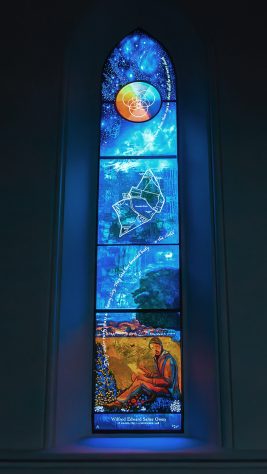Redina, Natasha

Stevens Competition Commission Winner 2022
Natasha Redina is the proud winner of the Stevens Competition Commission for 2022. This was her second success in the competition having won the design only prize in 2021.
The 2022 Competition was run in association with the Dunsden Owen Association. The challenge was to design a window for All Saints Church in the village of Dunsden, Oxfordshire, to celebrate the period that the wartime poet Wilfred Owen spent in the village as a lay assistant to the vicar of the parish church. The period Owen spent in Dunsden had a profound effect on him and many commentators can see signs of the mature style of his poetry emerging during his time in the village.
Natasha Redina’s winning design is shown opposite and her Artistic Statement is here.
Artistic development
Natasha Redina is of Anglo-Greek heritage and as a result she says that light has always been of importance to her. “I remember the stark contrast of light; the muted green, grey and brown tones of England as opposed to the bright blues and whites of Greece. Through the constantly changing environments I experienced, I came to the understanding that there were many hues through which life could be experienced.’’
Studying world religions at SOAS gave her a foundation in sacred art/architecture, biblical/spiritual imagery and narrative. Knowledge which was later deepened through her research into traditional cultures and her work as a transpersonal psychotherapist. Since 2011 she has been responding to a desire to work with her hands. She studied fine art and sculpture at City Lit and Morley College, London, as well as undertaking various course at The Prince’s Foundation School of Traditional Arts. It was here, in 2018, that she was first introduced to stained glass, and fell in love with the medium straight away.
“I am extremely excited by the scope of textures achievable on glass. I love the multidisciplinary nature of working with glass, from the initial concept, to research, to choosing the right glass and colour harmony, onto cutting, painting, firing and leading. Each part of the process is filled with challenges and growth. I am motivated by love of learning, exploration and experimentation. My aim is to continue the process of refining my skills and to contribute, in some small way, to enhancing and bringing beauty to public and private spaces through transmitted light.”
Natasha Redina notes that her journey of artistic exploration would have been impossible without the invaluable support and encouragement she received from so many quarters. “Genista Dunham who first taught me how to ‘cut from the heart’. Maria Zulueta from Morley College, whose fiery enthusiasm spurred me on throughout Covid. Jonathan, Ruth and Tom Cooke, who are a continued source of support and encouragement. Thomas Denny, whose work was a great inspiration and who took time out of his busy schedule to show me his studio. Steve Clare’s, encouragement from Holy Well Glass. And the generosity of Douglas Hogg and Jonathan Louth, who have kindly offered to help steer me through the complex process of realising this commission.
Central too have been The Worshipful Company and Glaziers and Painters of Glass and the Stevens Competition Committee who have given so generously of their time, so as to offer this invaluable opportunity to those starting out in this profession. I really encourage others, of any age, starting out in glass to submit an application. The process may seem daunting at first, but you learn so much along the way.”
Read more about Natasha Redina on her website: www.natasharedina.com
The Worshipful Company of Glaziers and the Stevens Competition
The Worshipful Company of Glaziers first appears in written records in 1364-65 during the reign of Edward III, when the emphasis was on the protection of the personal economic welfare of Glaziers. However, in recent times the focus has shifted to the preservation of the heritage of stained glass and to the support of education in architectural glass art, design and conservation.
In 1932 the Company launched an annual competition for young artists, which from 1972 operated under the banner of the Stevens Competition. The competition provided an opportunity for aspiring architectural glass artists, designers, and craftsmen to compete in a format which simulated the process typically undertaken in order to obtain a commercial commission.

